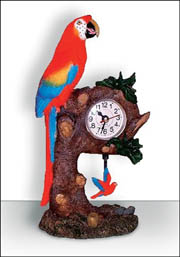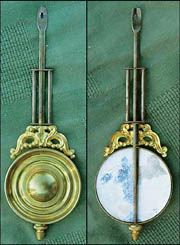
More on pendulums...
We assume that you did the experiment we carried for you in the
previous Science page and got to know that what really matters in a
pendulum is its length. Did you manage to find a length which swings
back and forth exactly 60 times in a minute? If you did,
congratulations! You are clever! Now you know the basic theory of an
accurate pendulum clock. Today, you can learn more about them.
In the clock's escapement (is made up of the pendulum, the anchor and
the escapement gear; this precisely regulates the speed at which the
weight's energy is released), there is a gear with teeth of a special
shape.
Basic idea
There is also a pendulum, and attached to the pendulum is some sort
of device to engage the teeth of the gear. The basic idea of this is
that, for each swing of the pendulum back and forth, one tooth of the
gear is allowed to 'escape'.

For example, if the pendulum is swinging towards, the left and passes
through the centre position, then, as the pendulum continues towards the
left, the left-hand stop attached to the pendulum will release its
tooth. The gear will then advance one-half tooth's-width forward and hit
the right-hand stop.
In advancing forward and running into the stop, the gear will make a
sound... 'tick' or 'tock' sounds being the most common.
That is where the ticking sound of a clock or watch comes from! One
thing to keep in mind is that pendulums will not swing forever!
Therefore, one additional job of the escapement gear is to impart just
enough energy into the pendulum to overcome friction, and allow it to
keep swinging.
To accomplish this task, the anchor (the name given to the instrument
attached to the pendulum to release the escapement gear one tooth at a
time) and the teeth on the escapement gear are especially shaped.
The gear's teeth escape properly, and the pendulum is given a push in
the right direction by the anchor, each time through a swing. The push
is the boost of energy that the pendulum needs to overcome friction, so
it keeps swinging. So, let's say that you created an escapement.

If you gave the escapement gear 60 teeth and attached this gear
directly to the weight drum, and if you then used a pendulum with a
period of one second, you would have successfully created a clock in
which the second hand turns at the rate of one revolution per minute.
By adjusting the pendulum's length very carefully, we could create a
clock with very high accuracy. But, do you think it's still accurate?
This will not be that useful because we use hour and minute hands in the
clock as well. We can't wind our clocks every 20 minutes, can we? This
can be solved by creating a high-ratio gear train that causes the drum
to make perhaps one turn every six to 12 hours.
This would give you a clock that you only had to rewind once a week,
or so. You can see that if you let the escapement gear itself drive
another gear train with a ratio of 60:1, then you can attach the minute
hand to the last gear in that train. A final train with a ratio of 12:1
would handle the hour hand. Wow!
We've got a clock now, but there are some small problems in this
clock. In our clock, the hour, minute and second hands are on different
axes.
We can solve this by using tubular shafts on the gears and then by
arranging the gear trains so that the gears driving the hour, minute and
second hands share the same axis. You can see this arrangement in any
clock.
The problem of not being able to wind the clock can be handled by
having a gear that can be slipped out of the train. When you pull on the
stem of a wristwatch to set the watch, that's what you are doing. Now,
do you still think clocks are complicated?
Compiled by Janani Amarasekara |


